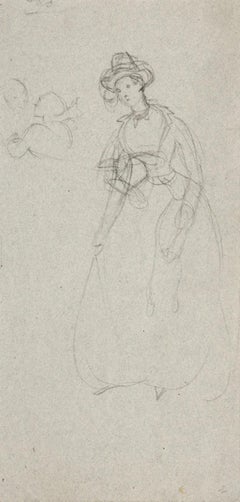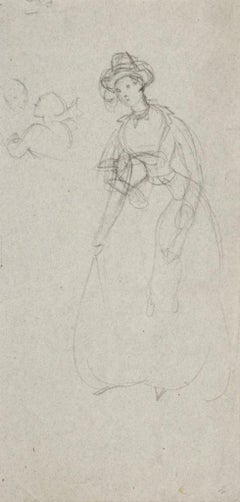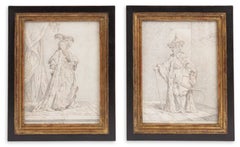Edmound De Beaumont Art
to
1
2
Overall Width
to
Overall Height
to
2
2
2
2
2
2
2
2
1
1
2
9,514
2,710
1,375
1,361
1
Artist: Edmound De Beaumont
Woman Figure - Original Pencil Drawing by Edmond De Beaumont - 1853
By Edmound De Beaumont
Located in Roma, IT
"Woman Figure" is an original pencil drawing on paper realized by Edmound De Beaumont in 1853.
Hand-signed on the rear.
Good conditions.
The drawing represents a woman in victorian costume...
Category
1850s Modern Edmound De Beaumont Art
Materials
Etching
Woman Figure - Pencil on Paper - 1853
By Edmound De Beaumont
Located in Roma, IT
"Woman Figure" 1853's is a drawing on paper, signed and dated by Edmond De Beaumont, on the back of the drawing.
In excellent conditions: as good as new...
Category
1850s Modern Edmound De Beaumont Art
Materials
Pencil
$289 Sale Price
30% Off
Related Items
Costume drawings for ‘Ambassadeur de Siam’ and ‘La Sultana Reine’
Located in Amsterdam, NL
Joseph-Marie Vien (1716-1809)
‘Ambassadeur de Siam’ and ‘La Sultana Reine’
Both titled lower centre, the drawing of the ambassador inscribed with colours intended for the prints, e...
Category
Mid-18th Century Old Masters Edmound De Beaumont Art
Materials
Paper, Pencil
$8,166
H 9.26 in W 6.89 in D 1.19 in
"Contemplation"
By Gershon Benjamin
Located in Lambertville, NJ
Jim’s of Lambertville is proud to offer this artwork by:
Gershon Benjamin (1899-1985)
An American Modernist of portraits, landscapes, still lives, and the urban scene, Gershon Benj...
Category
1920s Modern Edmound De Beaumont Art
Materials
Graphite
Chef Basting Chicken with Madeline Watching
By Ludwig Bemelmans, 1898-1962
Located in Miami, FL
This large Bemelans features a small image of Madeline in the smoke behind the chef's face. It was most likely preliminary work for an illustration with Madeline and the Chef that a...
Category
1950s American Modern Edmound De Beaumont Art
Materials
Paper, Watercolor, Gouache, Pencil
$24,000
H 27 in W 21.25 in
Modern Early Black and White Charcoal Artist Self Portrait Drawing
Located in Houston, TX
Modern early black and white artist self portrait by Houston artist Edsel Cramer. The work features a young portrait of the artist staring directly forward and cropped within an off-...
Category
1940s American Modern Edmound De Beaumont Art
Materials
Paper, Charcoal, Graphite
$1,500
H 18.75 in W 16.75 in D 0.5 in
A Handsome 1940s Portrait of a Seated Man by Chicago Artist, Harold Haydon
By Harold Haydon
Located in Chicago, IL
A Handsome 1940s Portrait of a Seated Man by Chicago Modern Artist, Harold Haydon (Am. 1909-1994). A wonderfully executed line drawing dating from 1946 with great character; looks ...
Category
Mid-20th Century American Modern Edmound De Beaumont Art
Materials
Paper, Graphite
$135
H 20 in W 16 in D 0.13 in
Young man in a toga elegant man Latin American hyperrealist Hockney style
By Claudio Bravo
Located in Norwich, GB
Superb original drawing in coloured conté pencils, heightened with white on oatmeal coloured vergé paper by Claudio Bravo. The work was created during the artist's Moroccan period, a...
Category
1970s Modern Edmound De Beaumont Art
Materials
Conté, Laid Paper, Color Pencil
$7,500
H 30.32 in W 24.02 in D 0.4 in
1940s Charcoal and Pencil Portrait of a Man
Located in Arp, TX
Artist Unknown
"Tie and Glasses"
c. 1940s
Charcoal and pencil on paper
13.5"x17" site 19"x23" rustic wood frame
Unsigned
Category
1940s Modern Edmound De Beaumont Art
Materials
Paper, Charcoal, Carbon Pencil
A Sensitive 1950s Mid-Century Modern Portrait of a Young Man By Harold Haydon
By Harold Haydon
Located in Chicago, IL
A Sensitive, Finely Rendered 1950s Mid-Century Modern Portrait of a Young Man By Noted Chicago Artist, Harold Haydon (Am. 1909-1994). Artwork size: 12 x 9 1/2 inches. Artwork is un...
Category
Mid-20th Century American Modern Edmound De Beaumont Art
Materials
Paper, Graphite
$385
H 16 in W 12 in D 0.13 in
Circus girl reclining
By Walt Kuhn
Located in Miami, FL
Signed and dated center right, Seam down center where two sheets attached is original. Some slight surface smudging outside figure area .
Category
1920s Modern Edmound De Beaumont Art
Materials
Carbon Pencil, Magazine Paper
beggars spanish modernism colored pencils
By Ricard Opisso Sala
Located in Sitges, Barcelona
Ricard Opisso - Beggars - Colored pencils
Measurements drawing 21x31cm.
Frame measures 39x48 cm.
Damaged paper at bottom.
Anti-reflective glass.
Son of Alfredo Opisso y Viñas, journalist, historian and critic, and of Antonia Sala y Gil, his sister Regina Opisso, was also a writer. He comes from an enlightened family full of artists. His paternal grandfather was Josep Opisso y Roig, journalist and director of the Diari de Tarragona, father of the also writers Antonia Opisso y Viña and Antoni Opisso y Viña. His maternal great-grandfather was the painter Pere Pau Montaña, his maternal grandfather the fabulist Felipe Jacinto Sala and his maternal uncle, the painter Emilio Sala y Francés. His nephew was Arturo Llorens y Opisso, a writer better known under his pseudonym Arturo Llopis.
Although he was born in Tarragona, his family moved to Barcelona when Opisso was only two years old. In modernist Barcelona at the end of the 19th century, Opisso worked as an assistant to Antonio Gaudí in the works of the Sagrada Familia in Barcelona since 1892. He was linked to the group Els Quatre Gats, along with Ramón Casas...
Category
1940s Modern Edmound De Beaumont Art
Materials
Color Pencil
$2,248 Sale Price
47% Off
H 8.27 in W 12.21 in
Untitled (Sunset Tower Hotel)
By Ed Templeton
Located in New York, NY
Listing includes framing with UV plexi, free shipping and a 14 day return policy.
Ed Templeton
Untitled (Sunset Tower Hotel), 2019
Image size: 11 ...
Category
2010s Contemporary Edmound De Beaumont Art
Materials
Acrylic, Ballpoint Pen, Pencil, Color Pencil
Mon Colonel
By Auguste Chabaud
Located in London, GB
'Mon Colonel', pencil and crayon on paper, by noted French artist, Auguste Chabaud (circa 1914-1918). A delightfully simple drawing of a French Army colonel in profile along with clo...
Category
1910s Modern Edmound De Beaumont Art
Materials
Paper, Crayon, Pencil
Edmound De Beaumont art for sale on 1stDibs.
Find a wide variety of authentic Edmound De Beaumont art available for sale on 1stDibs. You can also browse by medium to find art by Edmound De Beaumont in etching, pencil and more. Much of the original work by this artist or collective was created during the 19th century and is mostly associated with the modern style. Not every interior allows for large Edmound De Beaumont art, so small editions measuring 5 inches across are available. Edmound De Beaumont art prices can differ depending upon medium, time period and other attributes. On 1stDibs, the price for these items starts at $390 and tops out at $391, while the average work can sell for $391.


